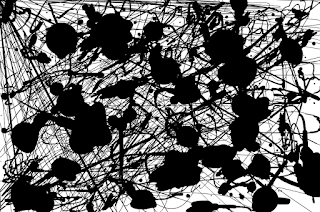Jackson Pollocks action paintings and playing with imagery in my Urban project.
 |
| Ink splatter I |
 |
| Transition through a tunnel |
 |
| Negative spaces |
Its interesting to play with your perception of what you actually see, its not always about physical objects as seen in my drawing of negative space.
My world of drawing has been opened thanks to the perseverance of MS who has encouraged me to broaden my approach with 'Wall Art' and to think about setting small challenges for myself. This has definately helped me break the mental block I had come up against. Artists such as Fiona Robinson, Discords II a Jerwood prize, shortlist, Anthony Gormley, Sol Lewitt and Richard Wright all looked at lines using buildings or walls to exhibit, they alll had extremely different styles but from them my ideas culminated. Development of my 'Horizon' series led me to draw an 8m long horizon down the public corridor in the Art School, for me that was not just about the illusion of the horizon viewed from different angles but it was about the social aspect of working and getting people involved in talking about my work as they walked past.
 |
| MDF drawings |
 |
| 8m long Horizon |
 |
| Terrington Fen |
Working Pleine Air in the Fens was liberating, quick fibre pen and pastel sketches of the flat landscape, recording the landscape ready for the studio.I love working outside, I think your brain not only captures what you see but somehow captures the atmosphere more accurately. Fred Ingrams a Fen artist works solely pleine air captures the essence of the Fens fantastically through clean lines and blocks of vibrant colour.
 |
| Terrington Marsh & Onion Field |
Photography has also played a major role in my investigation and recording of work, developing into drawings on MDF experimenting with imagery for the final piece.
 |
| Fen Horizon II |
 |
| Fen Horizon I |
Investigation and development of my ideas for presenting my ceramic installation, superimposing a photographic image over my Fen drawings, this was a completely new technique which is really effective and I shall definitely be developing this further.
It has been quite a journey for me on this drawing module, I have definitely grown as an artist and now after several months of experimenting have allowed myself to 'get it'. I think my major major mental block is that it had to be part of a process, but infact Ive learnt its all about investigation, developing ideas and recording these, it just so happens that in this courses context this activity is classified as 'drawing'.
I feel the world of drawing is at last really opening up for me, I just need to be open myself and allow the process side of things take a backseat.
Source:
http://www.fionarobinson.files.wordpress.com/2012/01/discords-ii.jpg
http://www.tate.org.uk/art/artworks/lewitt-wall-drawing-1136-ar00165/image-292687
http://www.antonygormley.com/drawing/series
http://www.contemporaryartdaily.com/2014/09/richard-wright-at-the-modern-institute/
http://www.webexhibits.org/colorart/abstract-expressionism.html
http://jacksonpollock.org
http://www.fredingrams.com












































